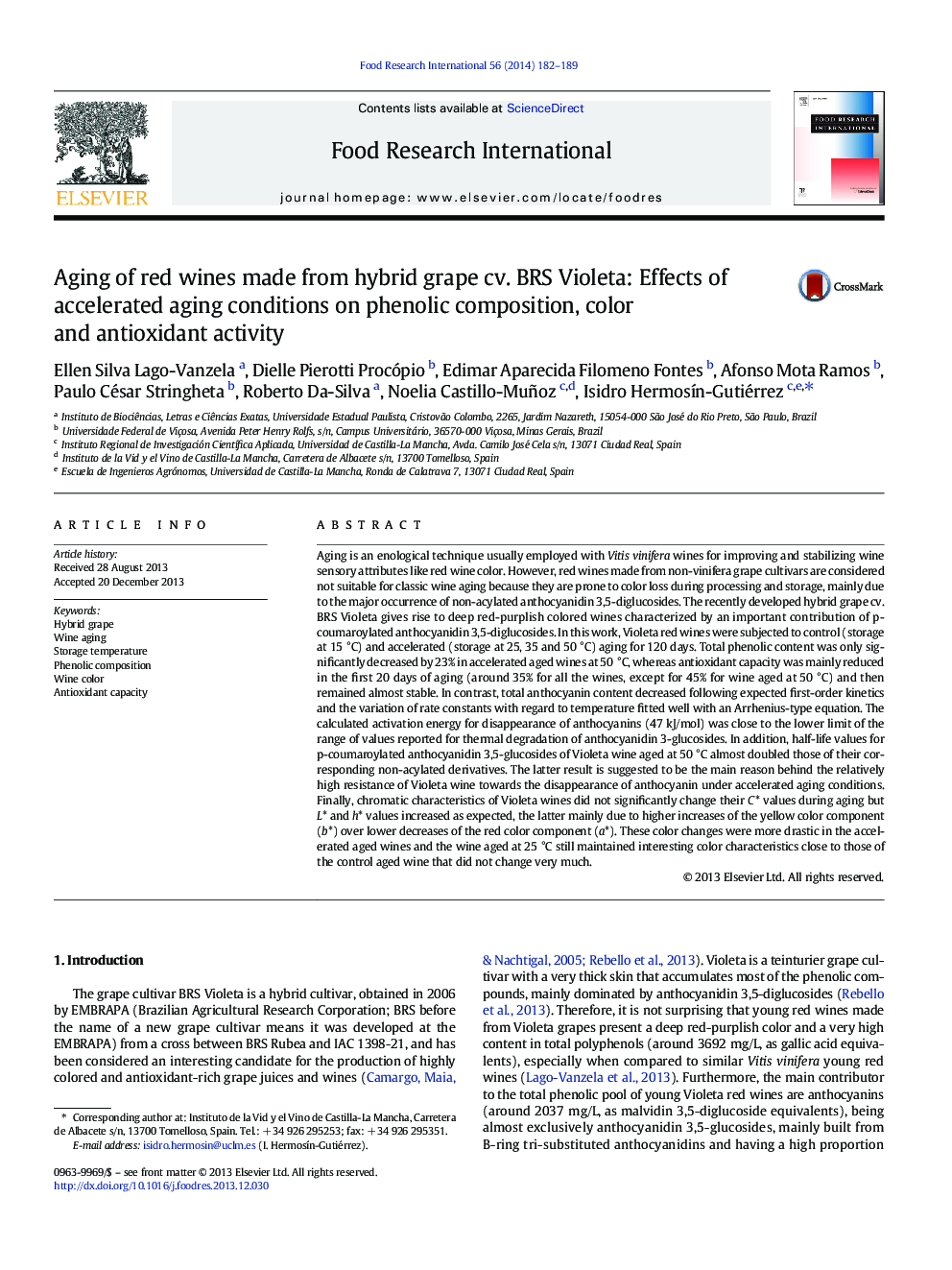| کد مقاله | کد نشریه | سال انتشار | مقاله انگلیسی | نسخه تمام متن |
|---|---|---|---|---|
| 6397005 | 1628488 | 2014 | 8 صفحه PDF | دانلود رایگان |
عنوان انگلیسی مقاله ISI
Aging of red wines made from hybrid grape cv. BRS Violeta: Effects of accelerated aging conditions on phenolic composition, color and antioxidant activity
دانلود مقاله + سفارش ترجمه
دانلود مقاله ISI انگلیسی
رایگان برای ایرانیان
کلمات کلیدی
موضوعات مرتبط
علوم زیستی و بیوفناوری
علوم کشاورزی و بیولوژیک
دانش تغذیه
پیش نمایش صفحه اول مقاله

چکیده انگلیسی
Aging is an enological technique usually employed with Vitis vinifera wines for improving and stabilizing wine sensory attributes like red wine color. However, red wines made from non-vinifera grape cultivars are considered not suitable for classic wine aging because they are prone to color loss during processing and storage, mainly due to the major occurrence of non-acylated anthocyanidin 3,5-diglucosides. The recently developed hybrid grape cv. BRS Violeta gives rise to deep red-purplish colored wines characterized by an important contribution of p-coumaroylated anthocyanidin 3,5-diglucosides. In this work, Violeta red wines were subjected to control (storage at 15 °C) and accelerated (storage at 25, 35 and 50 °C) aging for 120 days. Total phenolic content was only significantly decreased by 23% in accelerated aged wines at 50 °C, whereas antioxidant capacity was mainly reduced in the first 20 days of aging (around 35% for all the wines, except for 45% for wine aged at 50 °C) and then remained almost stable. In contrast, total anthocyanin content decreased following expected first-order kinetics and the variation of rate constants with regard to temperature fitted well with an Arrhenius-type equation. The calculated activation energy for disappearance of anthocyanins (47 kJ/mol) was close to the lower limit of the range of values reported for thermal degradation of anthocyanidin 3-glucosides. In addition, half-life values for p-coumaroylated anthocyanidin 3,5-glucosides of Violeta wine aged at 50 °C almost doubled those of their corresponding non-acylated derivatives. The latter result is suggested to be the main reason behind the relatively high resistance of Violeta wine towards the disappearance of anthocyanin under accelerated aging conditions. Finally, chromatic characteristics of Violeta wines did not significantly change their C* values during aging but L* and h* values increased as expected, the latter mainly due to higher increases of the yellow color component (b*) over lower decreases of the red color component (a*). These color changes were more drastic in the accelerated aged wines and the wine aged at 25 °C still maintained interesting color characteristics close to those of the control aged wine that did not change very much.
ناشر
Database: Elsevier - ScienceDirect (ساینس دایرکت)
Journal: Food Research International - Volume 56, February 2014, Pages 182-189
Journal: Food Research International - Volume 56, February 2014, Pages 182-189
نویسندگان
Ellen Silva Lago-Vanzela, Dielle Pierotti Procópio, Edimar Aparecida Filomeno Fontes, Afonso Mota Ramos, Paulo César Stringheta, Roberto Da-Silva, Noelia Castillo-Muñoz, Isidro HermosÃn-Gutiérrez,